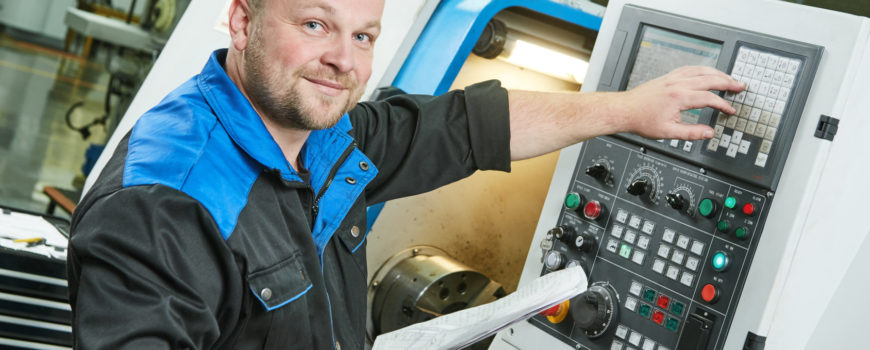In today’s world there is a great deal of focus on sustainability and energy efficiency. It seems everything, from cars to buildings, is measured by its carbon footprint, or environmental impact. Other countries, such as the United Kingdom, have strict energy regulations in place for manufacturing industries and for machine shops. The United States currently does not have any formal regulations regarding energy usage, but that should not stop the CNC machinist from doing everything in his or her power to limit energy consumption in their machine shop.
Limiting the amount of energy used within the machine shop has several benefits. Of course, limited energy expenditure is more environmentally friendly, reducing the amount of electricity pulled from the power grid. Reducing energy also has a trickle down benefit to the machine shop owner, OEMs, clients, and customers alike. Less energy usage can reduce the amount of money spent on electricity, replacement parts and tools, and waste material. Saving money in the manufacturing process is the key to success by allowing the shop to create an environmentally conscious product for less money.
Mindful Process Changes
One way a CNC machine shop is able to become more energy efficient is by making mindful and impactful process changes. There has been a great deal of research conducted regarding the amount of energy consumed within the manufacturing process. By making strategic and thoughtful decisions related to the process of creating components, it is possible to create a more energy efficient process.
Cycle Time
Selecting tools that can both increase a faster feed rate, while reducing feed time, is an excellent way to impact the cycle time between completed components. In one study, simply selecting the right tool for the job made all the difference. Consider the advantage to using multi-fluted tools. This is a great way to deliver instant energy savings over the course of the manufacturing process. The higher amount of flutes allows for a shorter cycle time, creating more parts per minute.
There is some trade off though, so the CNC machinist must be strategic in their selection. More flutes, and thus more components, is not always better. In some cases, while more flutes can certainly increase production, wear on the component can become a challenge. Multi-fluted tools, or specialty tools, can be expensive to replace. Further, more fluting can often result in irregular wear patterns which means the tool has an overall shorter lifespan. Understanding the broader reaching purpose for the job, and selecting the right tool, will ultimately find a happy medium. The key to cycle time energy efficiency is being able to balance the cycle time increases with the life expectancy of the tool.
Coolant Process
Another area machine shops are able to find energy saving changes is within the coolant process. Often, coolant delivered to the tools via through-tool delivery help to prolong the life of the tool. This method can increase how long a tool can be used, thus saving money and resources on replacement parts. Further, using through-tool coolant can make the wear on the various tool components more uniform. If the wear is uniform, it helps the CNC machinist predict the wear pattern, thus increasing the usability of the tool.
Further, there are methods to use coolant recycling systems. These systems can easily be connected to the machine plant cell. They work by combining a combination of recycled coolant with new coolant. Studies have shown that by mixing recycled and new coolant there are no noticeable differences in performance. Not only does this recycling method help to reduce coolant costs, but it has also shown to cut water usage by upwards of 10%.
Software Programming
Using various available software programs to better aid in the manufacturing process, particularly for custom machined parts, helps to save energy. Specialized programing is available to help create a custom tool path. This allows the user to maintain uniform stress on the tool, keeping constant and even pressure, to create a curving, circular path. Using this continuous, smooth motion allows the machinist to create the component with faster cutting speeds, without risk of tool damage with sudden, sharp turns, thus reducing energy costs.
Another software element indispensable in precision manufacturing is specialized programming that allows the tool to cut with uniform force. Having a steady cutting force results in energy reduction without varying forces and additional electric input to adjust for changing pressures.
Machine Tool Selections
Aside from making logical and strategic processing decisions, the tools within the machine shop itself can be energy efficient. There are several tools designed for energy efficiency, especially with the eco-friendly mindset of several companies and customers alike.
Limit Base Load
There are many energy-sapping functions within a tool that can go unnoticed, aside from the immediate energy load required to operate the tool during active phases. Many auxiliary parts continue to run, even while the tool is in between phases. The tool’s base load still consumes energy even while the tool is resting. Luckily, there are many new tools that can be switched off during these non-productive phases which can help save on energy costs.
Tool Selection
Addressed earlier while mentioning the practice of selecting the right tool to increase cycle times, tool selection can also impact the amount of energy consumed. Of the many components, a spindle can greatly impact the tool’s efficiency. If the spindle drive is run too slowly, below it’s intended operating speed, it can eat up a tremendous amount of unnecessary energy. Further, throttling the tool to reduce the speed only increases the time it takes to manufacture a component. Increased manufacture time leads to an increased use of electricity. It is recommended that spindle motor efficiency is considered for the component in question. Sometimes energy efficiency can be improved by using synchronous motors as opposed to asynchronous motors.
Regenerative Supply Usage
Lastly, tools are now made in precision manufacturing that have a regenerative energy supply. Traditionally, fast moving tools require an internal braking system to slow down the acceleration. In a non-regenerative system the power used to brake the tool is converted to heat, from friction, which is then lost in the overall process. Regenerative tools are now available that redirect that lost energy into useable kinetic energy, sent right back to the power grid.
This regenerative supply can help save energy in several ways. Not only can regenerative power help maintain consistent power to the tool, foregoing the momentary power loss sometimes exhibited when the tool starts and stops, but it can also help in processes that require multiple tool changes. In systems that require one, or multiple tool changes within 100 seconds regenerative power supplies are able to keep constant energy to the system. In a non-regenerative tool, the power it takes to restart the machine after a tool change spikes, drawing an excess amount of power from the grid. This can be avoided with a regenerative tooling system.
Just because the United States has not fully regulated energy consumption by machine shops nationwide, does not mean manufacturers are not interested in the valuable savings associated with energy efficiency. Conserving energy is a key factor for an original equipment manufacturer in the Denver manufacturing market. Between prolonging the life expectancy of tools, saving money on energy costs, and making environmentally friendly choices it is clear that energy efficiency is the path for a successful manufacturing process.
Check out another article on renewable energy in Manufacturing.



